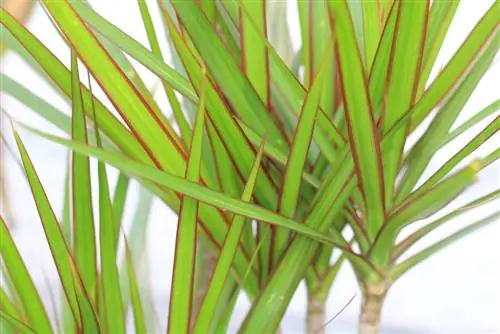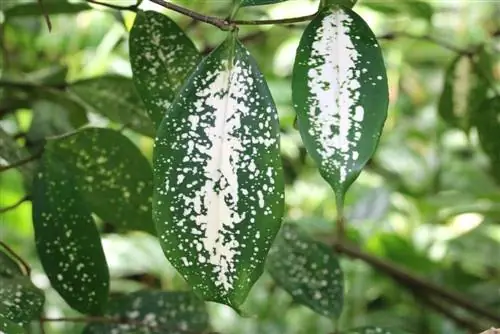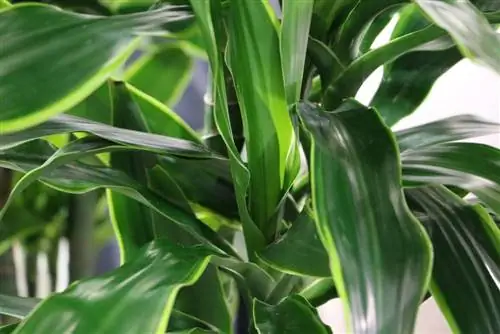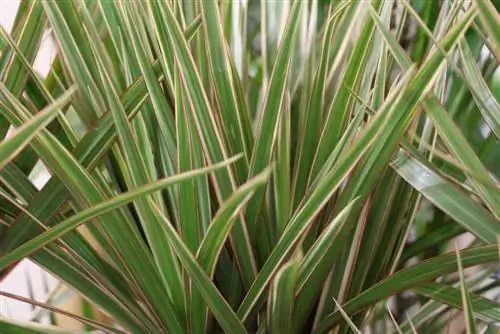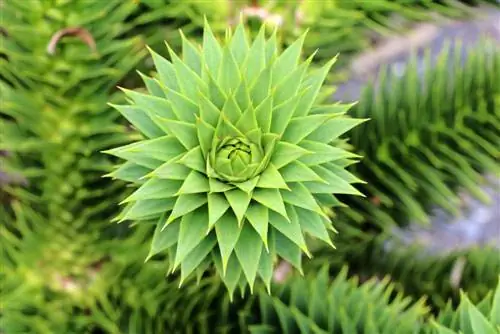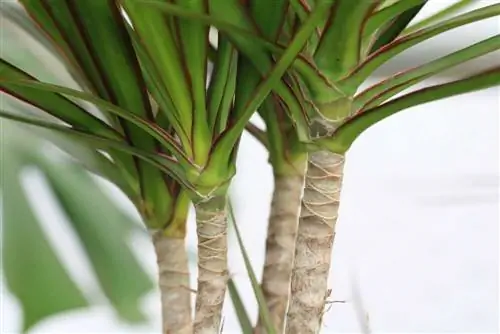- Author admin [email protected].
- Public 2023-12-17 03:39.
- Last modified 2025-06-01 06:48.
The good old dragon tree is only supposedly one of our most famous houseplants - because very few people have any idea of the diversity in which the dragon tree genus is available to decorate our living spaces. Anyone who takes a closer look at this variety will quickly become a dragon tree fan; especially when he notices that the foliage plants develop highly attractive flowers when properly cared for.
Profile
- Dragon trees represent a large genus with the scientific name Dracaena
- Which (more peaceful than the name sounds) belong to the asparagus family
- They are tree-shaped life forms that form their trunks in an atypical shape
- This atypical growth works very well:
- Dracenes, as older plants, usually grow up to two meters high
- You can do this with care that won't overwhelm even beginners
- If dragon trees become larger than planned, they can be “brutally shortened”
- Propagation is easy, e.g. B. about the plant parts cut away when shortening
- If you want your dragon tree to be something very special, you should look into flower induction
Location
All dragon trees cultivated by us have their home in tropical/subtropical regions. Since the “tropical belt” follows the equator, they are used to light of a completely different intensity than they get here “in the far north”.
The location should therefore be bright; The closer the brightness approaches the equatorial light, the more colorful foliage decorations the Dracaena can and will produce. The other way around “it also makes a big difference”: the beautifully colored dracaena shown in the picture will only show this magnificent color in your household if it gets enough light.
The drazenes only like direct sun after they get used to it, even when spending the summer outdoors. Otherwise you can enjoy it until almost frost sets in, as long as it also offers a little protection from the rain and the roots in the bottom of the pot are not made to shiver directly on cold ground.
If a dragon tree receives light on one side, it should be rotated every few weeks, otherwise it will grow (lopsidedly) towards the light.
Tip:
The dragon tree is definitely worth a few considerations about its location, because it brings a long-lasting companion into your home: the Canarian Dracaena draco is said to live at least 400 years (maybe even 1.000 or 3,000, see “Drago Milenario” in Icod de los Vinos, Tenerife, de.wikipedia.org/wiki/Icod_de_los_Vinos). Of the other Dracenes, no more than a few decades have survived; However, all dragon trees can probably live to a more than proud old age.
Pot, substrate, repotting
If the sales pot seems rather small in relation to the plant, it is best to put the Dracaena in a new pot immediately so that the roots have enough space.

You can also surround the dragon tree with fresh earth. Take a closer look at the potted roots; various developmental stages of small animals that you would rather not have in the house have often nested in the soil of sales pots. If you discover grains of an unusual color in the soil, you should probably remove the pot soil from the pot as a precaution (shake it off, strip it off, and shower it off) and repot the dragon tree into a new pot and new soil.
If not, the usually not very high-quality substrate is simply replaced with good quality soil. The soil in the sales pot often has a high peat content; not only an environmental sin, but also bad for the longevity of the substrate: If peat dries out (which inevitably happens at some point somewhere in the pot), it no longer absorbs water. Diving helps, but soaked peat stays too wet for too long. So repot in quality soil: garden soil or a really good potting soil, to which some coarse sand or Seramis clay granules (lava, gravel, perlite, grit) are added to make them more permeable.
Dracenes can be repotted if necessary; The need arises at the latest when roots grow towards you on the edge of the pot or out of the drainage holes.
When repotting, the roots are again looked at: all rotten, dead, damaged roots are removed. But no more than this, any root cutting that goes beyond this (to stop growth in size, for rejuvenation) is a risk: If a decisive root cutting is a little too decisive, it can paralyze the growth of the old shoots or even bring them to a standstill.
Tip:
The pot size doesn't only become interesting when plants have to be repotted because of their size. It's actually the other way around: the pot size of the young plant determines the extent of the roots in the pot and thus the size and extent of the later plant mass. If you want to grow a huge dragon tree, get a larger pot from the start and plant plenty of roots in it to form a strong, stable base. A small pot only gives room for “small growth”; If the pot remains permanently too small, the growth will not be very nice.
Watering and fertilizing
A dracaena does not need water in large quantities; It should always only be watered when the soil in the pot has already dried out. The dracaenas are succulents, so they store water and therefore do better with a little dryness in between than with a substrate that is constantly too moist. The prerequisite, of course, is that the Dracaena has been able to “fill up” with water properly - there are certainly succulents that need to be “filled up” after purchase.
How often water?
Depends on the size of the plant, temperature and season, humidity in the area and ultimately how you feel. During the spring and summer growth phases, dragon trees need more water than during the dormant period; Otherwise: The root ball must neither lie dry for a long time nor be waterlogged for a long time. Any water that has run off in the saucer should always be emptied shortly after watering.
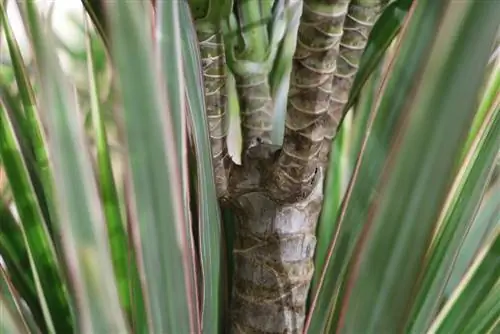
Dragon trees only need additional humidity from the spray bottle when the air is extremely dry in winter. Outside, in warm temperatures, a few raindrops that quickly dry away certainly won't do any harm; If the moisture in living spaces cannot dry well, the spray bottle is more likely to pave the way for fungal diseases.
The dragon tree is fertilized during the growth phases in spring and summer, approximately every 14 days until autumn. If the soil is not completely dead, half the concentration is enough; after repotting into pre-fertilized soil, take a break from fertilizing.
Cutting
Dragon trees can be cut quite easily, the trunk and the entire plant are very tolerant of pruning.
A dragon tree can be cut at any height, and this cutting of height is not uncommon for Dracaena: indoor gardeners do not necessarily assume that the small green plant will reach heights of up to two meters. If it is well cared for, a Dracaena grows quite quickly and quickly reaches a height that may no longer suit the chosen location.
A cut is also necessary if a single-stemmed specimen is to be encouraged to branch. This works best with young plants; if possible, cut over a sleeping eye. Older plants can also be “redesigned”; The higher the cut is made on the trunk, the more likely the plant will sprout again. If not: From the
Cutted plant parts can usually be used to grow a new plant.
Cropping is possible at any time; However, larger pruning measures should be carried out in spring at the beginning of the growing season because that is when the cuts heal fastest.
Tip:
If a dragon tree suffers from a lack of light, this is usually noticeable after a while and leads to the dragon tree being made brighter. So light that it gains a lot of weight at the top, but retains the trunk that is too thin. Results in a crooked plant with a critical center of gravity that is very similar to what appears above in the pot size tip in Link 2. The only thing that helps here is radical “heading”; with a bit of luck, the lower part will sprout several new trunks. The upper part can be rooted in water and then potted separately.
Bloom and flower induction
Whether you develop these flowers is up to you: To induce flowers, the dragon tree needs a few weeks of cool temperatures in early winter. 14 nights at temperatures below 10 °C should be enough to stimulate flowering.
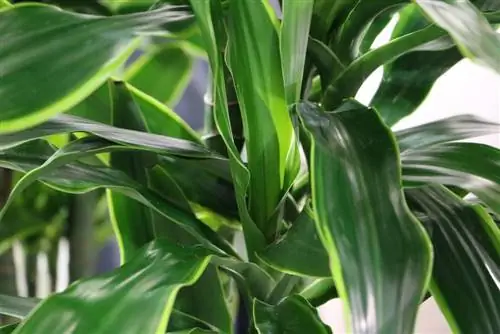
It works the other way around too: If you just want to keep a beautiful green plant, you can prevent flowering by keeping it at a constant temperature of at least 15 °C.
Overwintering, rest period
The temperature changes for flower induction are initiated during the dracaena's dormant period, which is between November and March.
Regardless of measures to induce flowers, the dragon tree receives limited watering during this time and no fertilizer during the entire rest period.
Propagation
The drazenes can be easily propagated from head cuttings or stem pieces.
Head cuttings root in a glass of water and usually also when they are potted directly in slightly moist soil. You can initially put a transparent plastic cover over them to increase the humidity, but well-dried dragon tree cuttings should also conquer their pot without any cocolore.
Stem pieces should sprout fastest if you let them dry first and then root them in water or soil (the right way up, as the trunk once grew).
The original species of Dracaena can of course also be propagated from seeds (cultivars do not always reproduce well); But getting the seeds won't be easy.
Species and varieties
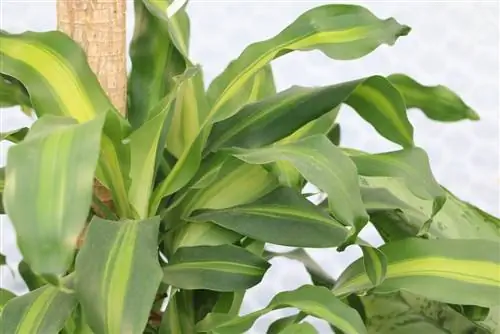
There are currently 113 species in the dragon tree genus. Unfortunately all from the tropics/subtropics, the following Dracaena species have proven to be suitable for rooms:
1. Dracaena fragrans, in some pretty varieties:
- D. fragrans 'Chinto'
- D. fragrans 'Dorado'
- D. fragrans 'Green Jewel'
- D. fragrans 'Green Stripe'
- D. fragrans 'Golden Coast'
- D. fragrans 'Jade Jewel'
- D. fragrans 'Janet Craig'
- D. fragrans 'Janet Craig Compacta'
- D. fragrans 'Kanzi'
- D. fragrans ‘Compacta’
- D. fragrans 'Lemon Lime'
- D. fragrans 'Lemon Surprise'
- D. fragrans 'Malaika'
- D. fragrans 'Massengeana'
- D. fragrans 'Riki'
- D. fragrans 'Santa Rosa'
- D. fragrans 'Surprise'
- D. fragrans 'Stedneri', is also sold as lucky bamboo
- D. fragrans 'Variegata'
- D. fragrans 'Warneckii'
- D. fragrans 'White Jewel'
- D. fragrans 'White Stripe'
- D. fragrans 'White Surprise'
- D. fragrans 'Yellow Coast'
The varieties differ in the leaf colors, but with this variety of cultivars they often differ so little that you would have to look for differences in direct (picture) comparison. You can also encounter Dracaena fragrans under the synonym D. deremensis.
2. In addition to the original form, Dracaena braunii (synonym D. sanderiana) has to offer:
- D. braunii 'Lucky Bamboo', the lucky bamboo, which has as much to do with bamboo as the dragon tree has to do with dragons
- D. braunii 'variegata' with variegated leaves in green-white and green-cream
Tip:
Lucky bamboo is often offered for cents, you only get a single shoot with one or two leaves. Because the dragon trees are so prone to sprouting and branching, you can turn the small branch into a real, large dragon tree: If necessary, let it root in water, plant it and encourage branching through pruning until the “stick with leaves” turns into a bushy one plant.
3. Dracaena reflexa, the (backward) twisted dragon tree, twists in several colors, shapes and cultivars:
- D. refelxa 'Anita'
- D. reflexa 'La Tigra'
- D. reflaxa 'Song of India'
- D. reflexa 'Song of Jamaica'
4. Dracaena reflexa var. angustifolia, margined dragon tree (synonym Dracaena marginata) is available as:
- D. reflexa var. angustifolia, original form, light green leaf blades with light yellow edge
- D. reflexa var. angustifolia marginata 'bicolor' is green with a red border
- D. reflexa var. angustifolia 'magenta' often shows leaves that are dark red down to the middle
- D. reflexa var. angustifolia 'tricolor', like bicolor plus a stripe of light yellow
Tip:
If you come across a Dracaena reflexa var. angustifolia (marginata) with narrow sword leaves but without a contrasting leaf edge - it is most likely a Mauritian Dracaena concinna. For some unknown reason, it is often sold under the wrong name Dracaena marginata. Except for the “dad green” leaf color, it's no problem, the Dracaena concinna is classified in hardiness zone 9 (can tolerate temperatures down to -7°C) and is therefore actually better suited to our climate than most other dragon trees, which can tolerate cold temperatures up to USDA zone 10 (max. -1.1 °C).
5. Dracaena surculosa (synonym D. godseffiana), spotted dragon tree, lives up to its name in the following varieties:
- D. surculosa original form, dark green with light markings
- D. surculosa 'Florida Beauty' with almost white variegation
- D. surculosa 'Gold Dust' really looks like it's heavily dusted with gold
6. The following exotic dragon trees are rarely on offer:
- Dracaena draco, Canary Islands dragon tree, exceptional in growth form and fruit stand
- Dracaena thalioides (synonym D. aubryana), almost stemless, large-leaved green, is said to have a lot of talent for flowering

